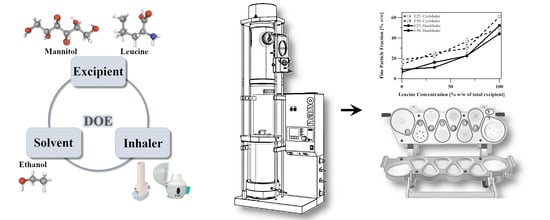Inhalable, Spray-Dried Terbinafine Microparticles for Management of Pulmonary Fungal Infections: Optimization of the Excipient Composition and Selection of an Inhalation Device
Abstract
:1. Introduction
2. Materials and Methods
2.1. Materials
2.2. Design of Experiments
2.3. Preparation of Formulations
2.4. Characterization of Formulations
2.4.1. Yield, Drug Load, and Drug Content Uniformity
2.4.2. Particle Morphology
2.4.3. Crystallinity
2.5. Evaluation of Formulations
2.5.1. Particle Disintegration and Dissolution
2.5.2. In Vitro Aerodynamic Performance (Cascade Impaction)
2.6. Data Analysis
3. Results
3.1. Characterization of Formulations
3.1.1. Yield, Drug Load, and Drug Content Uniformity
3.1.2. Particle Morphology
3.1.3. Crystallinity
3.2. Evaluation of Formulations
3.2.1. Particle Disintegration and Dissolution
3.2.2. In Vitro Aerodynamic Performance (Cascade Impaction)
4. Discussion
5. Conclusions
Author Contributions
Funding
Institutional Review Board Statement
Informed Consent Statement
Data Availability Statement
Acknowledgments
Conflicts of Interest
References
- Kousha, M.; Tadi, R.; Soubani, A.O. Pulmonary aspergillosis: A clinical review. Eur. Respir. Rev. 2011, 20, 156–174. [Google Scholar] [CrossRef] [Green Version]
- Cheng, S.N.; Tan, Z.G.; Pandey, M.; Srichana, T.; Pichika, M.R.; Gorain, B.; Choudhury, H. A Critical Review on Emerging Trends in Dry Powder Inhaler Formulation for the Treatment of Pulmonary Aspergillosis. Pharmaceutics 2020, 12, 1161. [Google Scholar] [CrossRef] [PubMed]
- Koehler, P.; Bassetti, M.; Chakrabarti, A.; Chen, S.C.A.; Colombo, A.L.; Hoenigl, M.; Klimko, N.; Lass-Flörl, C.; Oladele, R.O.; Vinh, D.C.; et al. Defining and managing COVID-19-associated pulmonary aspergillosis: The 2020 ECMM/ISHAM consensus criteria for research and clinical guidance. Lancet Infect. Dis. 2021, 21, e149–e162. [Google Scholar] [CrossRef]
- Arora, S.; Haghi, M.; Young, P.M.; Kappl, M.; Traini, D.; Jain, S. Highly respirable dry powder inhalable formulation of voriconazole with enhanced pulmonary bioavailability. Expert Opin. Drug Deliv. 2016, 13, 183–193. [Google Scholar] [CrossRef]
- Liao, Q.; Yip, L.; Chow, M.Y.T.; Chow, S.F.; Chan, H.-K.; Kwok, P.C.L.; Lam, J.K.W. Porous and highly dispersible voriconazole dry powders produced by spray freeze drying for pulmonary delivery with efficient lung deposition. Int. J. Pharm. 2019, 560, 144–154. [Google Scholar] [CrossRef]
- Almansour, K.; Alfagih, I.M.; Ali, R.; Elsayed, M.M.A. Inhalable microparticles containing terbinafine for management of pulmonary fungal infections: Spray drying process engineering using lactose vs. mannitol as excipients. J. Drug Deliv. Sci. Technol. 2020, 60, 101991. [Google Scholar] [CrossRef]
- Alhajj, N.; O’Reilly, N.J.; Cathcart, H. Leucine as an excipient in spray dried powder for inhalation. Drug Discov. Today 2021, 26, 2384–2396. [Google Scholar] [CrossRef]
- Boraey, M.A.; Hoe, S.; Sharif, H.; Miller, D.P.; Lechuga-Ballesteros, D.; Vehring, R. Improvement of the dispersibility of spray-dried budesonide powders using leucine in an ethanol–water cosolvent system. Powder Technol. 2013, 236, 171–178. [Google Scholar] [CrossRef]
- Wang, X.; Wan, W.; Lu, J.; Quan, G.; Pan, X.; Liu, P. Effects of L-leucine on the properties of spray-dried swellable microparticles with wrinkled surfaces for inhalation therapy of pulmonary fibrosis. Int. J. Pharm. 2021, 610, 121223. [Google Scholar] [CrossRef]
- Eedara, B.B.; Rangnekar, B.; Doyle, C.; Cavallaro, A.; Das, S.C. The influence of surface active l-leucine and 1,2-dipalmitoyl-sn-glycero-3-phosphatidylcholine (DPPC) in the improvement of aerosolization of pyrazinamide and moxifloxacin co-spray dried powders. Int. J. Pharm. 2018, 542, 72–81. [Google Scholar] [CrossRef]
- Shetty, N.; Park, H.; Zemlyanov, D.; Mangal, S.; Bhujbal, S.; Zhou, Q. Influence of excipients on physical and aerosolization stability of spray dried high-dose powder formulations for inhalation. Int. J. Pharm. 2018, 544, 222–234. [Google Scholar] [CrossRef]
- Aquino, R.P.; Prota, L.; Auriemma, G.; Santoro, A.; Mencherini, T.; Colombo, G.; Russo, P. Dry powder inhalers of gentamicin and leucine: Formulation parameters, aerosol performance and in vitro toxicity on CuFi1 cells. Int. J. Pharm. 2012, 426, 100–107. [Google Scholar] [CrossRef]
- Momin, M.A.M.; Sinha, S.; Tucker, I.G.; Doyle, C.; Das, S.C. Dry powder formulation of kanamycin with enhanced aerosolization efficiency for drug-resistant tuberculosis. Int. J. Pharm. 2017, 528, 107–117. [Google Scholar] [CrossRef]
- Li, L.; Leung, S.S.Y.; Gengenbach, T.; Yu, J.; Gao, G.; Tang, P.; Zhou, Q.; Chan, H.-K. Investigation of L-leucine in reducing the moisture-induced deterioration of spray-dried salbutamol sulfate power for inhalation. Int. J. Pharm. 2017, 530, 30–39. [Google Scholar] [CrossRef]
- Bodem, C.R.; Lampton, L.M.; Miller, D.P.; Tarka, E.F.; Everett, E.D. Endobronchial pH. Relevance to aminoglycoside activity in gram-negative bacillary pneumonia. Am. Rev. Respir. Dis. 1983, 127, 39–41. [Google Scholar] [CrossRef]
- Bhagwat, S.; Schilling, U.; Chen, M.-J.; Wei, X.; Delvadia, R.; Absar, M.; Saluja, B.; Hochhaus, G. Predicting Pulmonary Pharmacokinetics from In Vitro Properties of Dry Powder Inhalers. Pharm. Res. 2017, 34, 2541–2556. [Google Scholar] [CrossRef]
- Elsayed, M.M.A.; Cevc, G. Turbidity Spectroscopy for Characterization of Submicroscopic Drug Carriers, Such as Nanoparticles and Lipid Vesicles: Size Determination. Pharm. Res. 2011, 28, 2204–2222. [Google Scholar] [CrossRef]
- United States Pharmacopeia. General Chapters: Aerosols, nasal sprays, metered-dose inhalers, and dry powder inhalers. In The United States Pharmacopeia, Thirty-Seventh Revision, USB Flash Drive Version; The United States Pharmacopeial Convention: Rockville, MD, USA, 2014. [Google Scholar]
- Burger, A.; Henck, J.-O.; Hetz, S.; Rollinger, J.M.; Weissnicht, A.A.; Stöttner, H. Energy/Temperature Diagram and Compression Behavior of the Polymorphs of d-Mannitol. J. Pharm. Sci. 2000, 89, 457–468. [Google Scholar] [CrossRef]
- Li, L.; Sun, S.; Parumasivan, T.; Denman, J.A.; Gengenbach, T.; Tang, P.; Mao, S.; Chan, H.-K. L-Leucine as an excipient against moisture on in vitro aerosolization performances of highly hygroscopic spray-dried powders. Eur. J. Pharm. Biopharm. 2016, 102, 132–141. [Google Scholar] [CrossRef]
- Ordoubadi, M.; Gregson, F.K.A.; Wang, H.; Nicholas, M.; Gracin, S.; Lechuga-Ballesteros, D.; Reid, J.P.; Finlay, W.H.; Vehring, R. On the particle formation of leucine in spray drying of inhalable microparticles. Int. J. Pharm. 2021, 592, 120102. [Google Scholar] [CrossRef]
- Mangal, S.; Meiser, F.; Tan, G.; Gengenbach, T.; Denman, J.; Rowles, M.R.; Larson, I.; Morton, D.A.V. Relationship between surface concentration of l-leucine and bulk powder properties in spray dried formulations. Eur. J. Pharm. Biopharm. 2015, 94, 160–169. [Google Scholar] [CrossRef]
- Lechanteur, A.; Evrard, B. Influence of Composition and Spray-Drying Process Parameters on Carrier-Free DPI Properties and Behaviors in the Lung: A review. Pharmaceutics 2020, 12, 55. [Google Scholar] [CrossRef] [Green Version]
- Molina, C.; Kaialy, W.; Nokhodchi, A. The crucial role of leucine concentration on spray dried mannitol-leucine as a single carrier to enhance the aerosolization performance of Albuterol sulfate. J. Drug Deliv. Sci. Technol. 2019, 49, 97–106. [Google Scholar] [CrossRef]
- Focaroli, S.; Mah, P.T.; Hastedt, J.E.; Gitlin, I.; Oscarson, S.; Fahy, J.V.; Healy, A.M. A Design of Experiment (DoE) approach to optimise spray drying process conditions for the production of trehalose/leucine formulations with application in pulmonary delivery. Int. J. Pharm. 2019, 562, 228–240. [Google Scholar] [CrossRef] [PubMed]
- Liu, Q.; Guan, J.; Qin, L.; Zhang, X.; Mao, S. Physicochemical properties affecting the fate of nanoparticles in pulmonary drug delivery. Drug Discov. Today 2020, 25, 150–159. [Google Scholar] [CrossRef] [PubMed]
- Ghazanfari, T.; Elhissi, A.M.A.; Ding, Z.; Taylor, K.M.G. The influence of fluid physicochemical properties on vibrating-mesh nebulization. Int. J. Pharm. 2007, 339, 103–111. [Google Scholar] [CrossRef]
- Vehring, R. Pharmaceutical Particle Engineering via Spray Drying. Pharm. Res. 2008, 25, 999–1022. [Google Scholar] [CrossRef] [Green Version]
- Belotti, S.; Rossi, A.; Colombo, P.; Bettini, R.; Rekkas, D.; Politis, S.; Colombo, G.; Balducci, A.G.; Buttini, F. Spray-dried amikacin sulphate powder for inhalation in cystic fibrosis patients: The role of ethanol in particle formation. Eur. J. Pharm. Biopharm. 2015, 93, 165–172. [Google Scholar] [CrossRef]
- Mallard, C.; Willcox, N. Method of Dissolving Antifungal Agent, and Compositions with a High Concentration of Antifungal Agent, Suitable for Application to the Nail. U.S. Patent 20120309753 A1, 6 December 2012. [Google Scholar]
- Son, Y.-J.; Longest, P.W.; Tian, G.; Hindle, M. Evaluation and modification of commercial dry powder inhalers for the aerosolization of a submicrometer excipient enhanced growth (EEG) formulation. Eur. J. Pharm. Sci. 2013, 49, 390–399. [Google Scholar] [CrossRef] [PubMed] [Green Version]
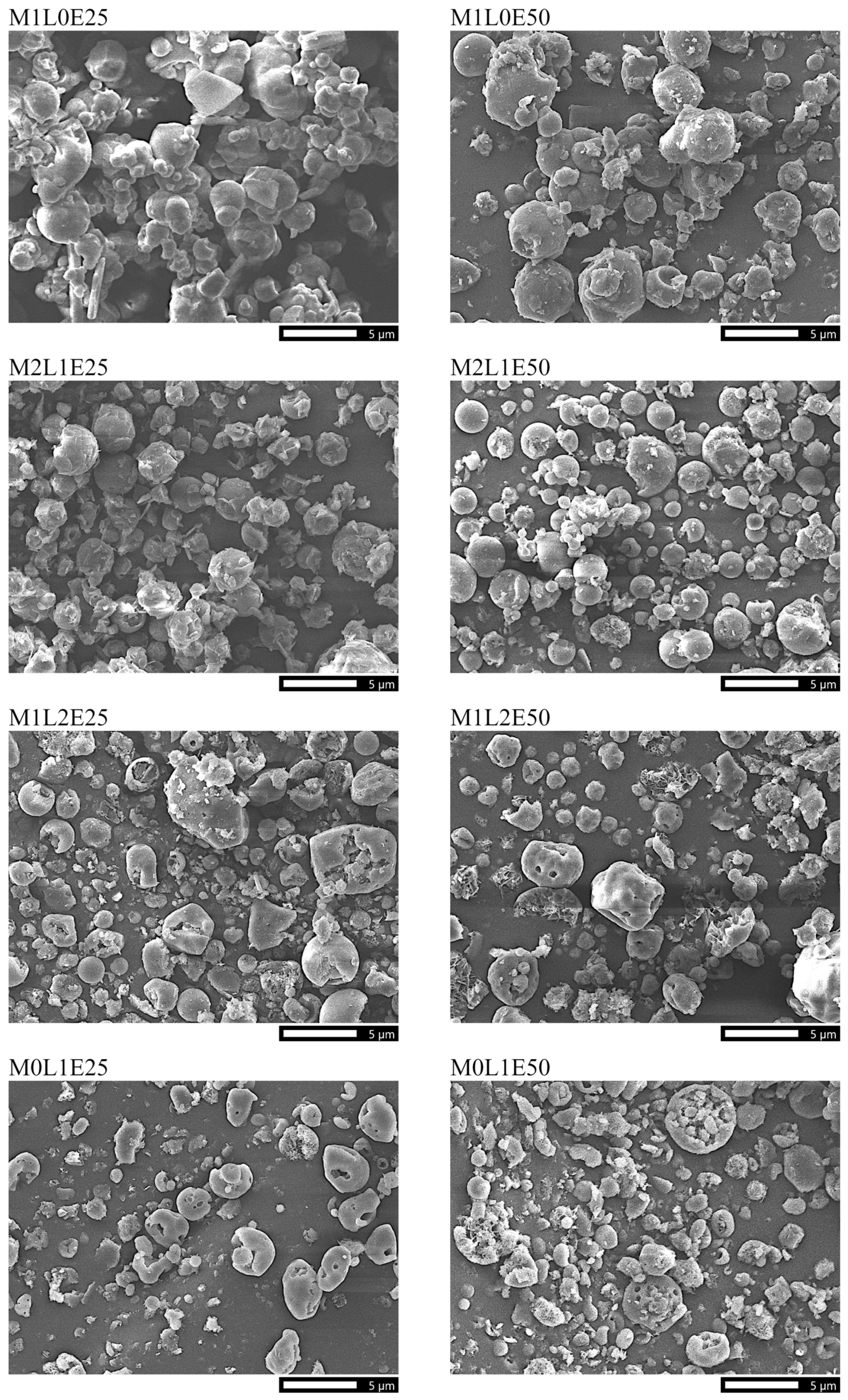
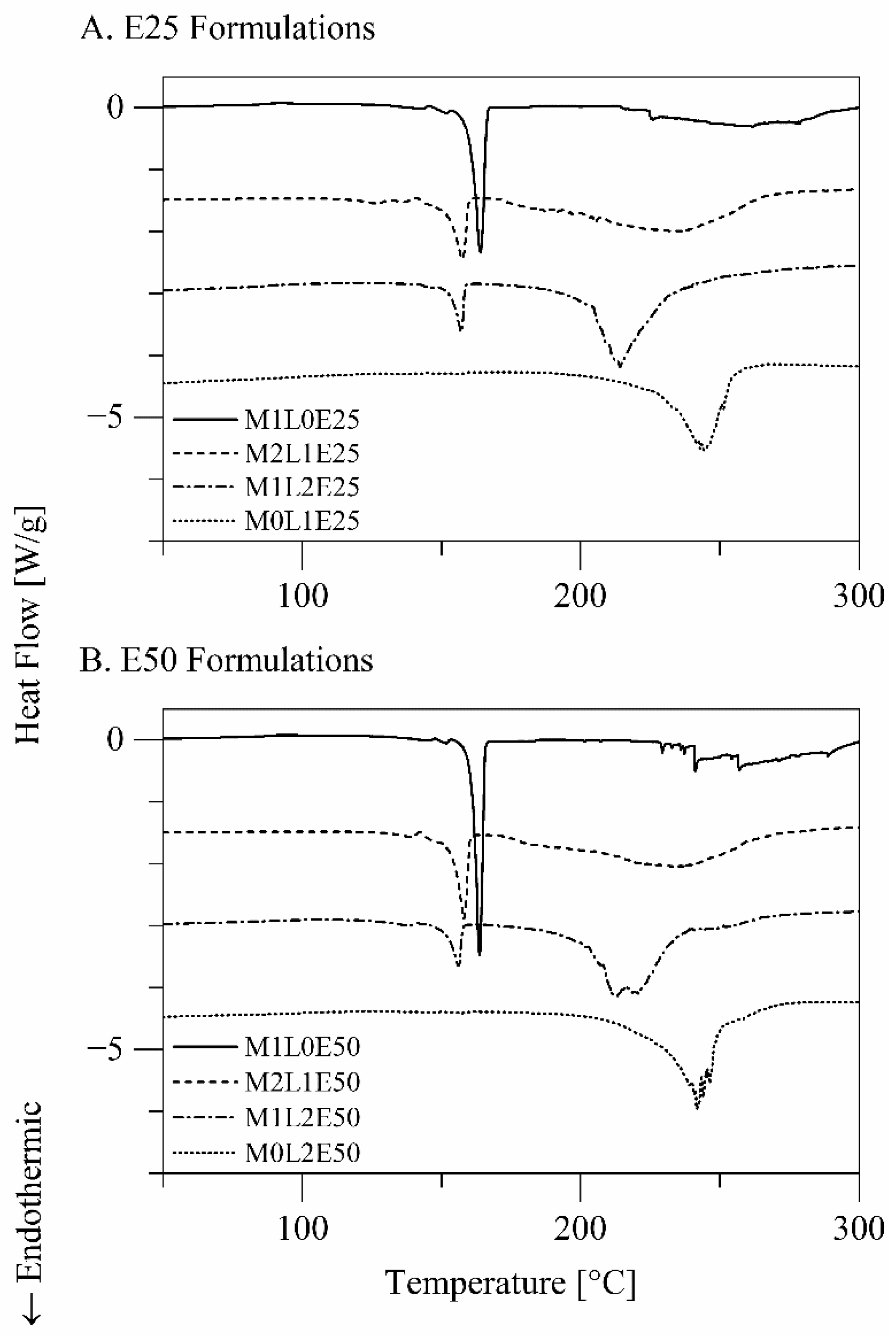
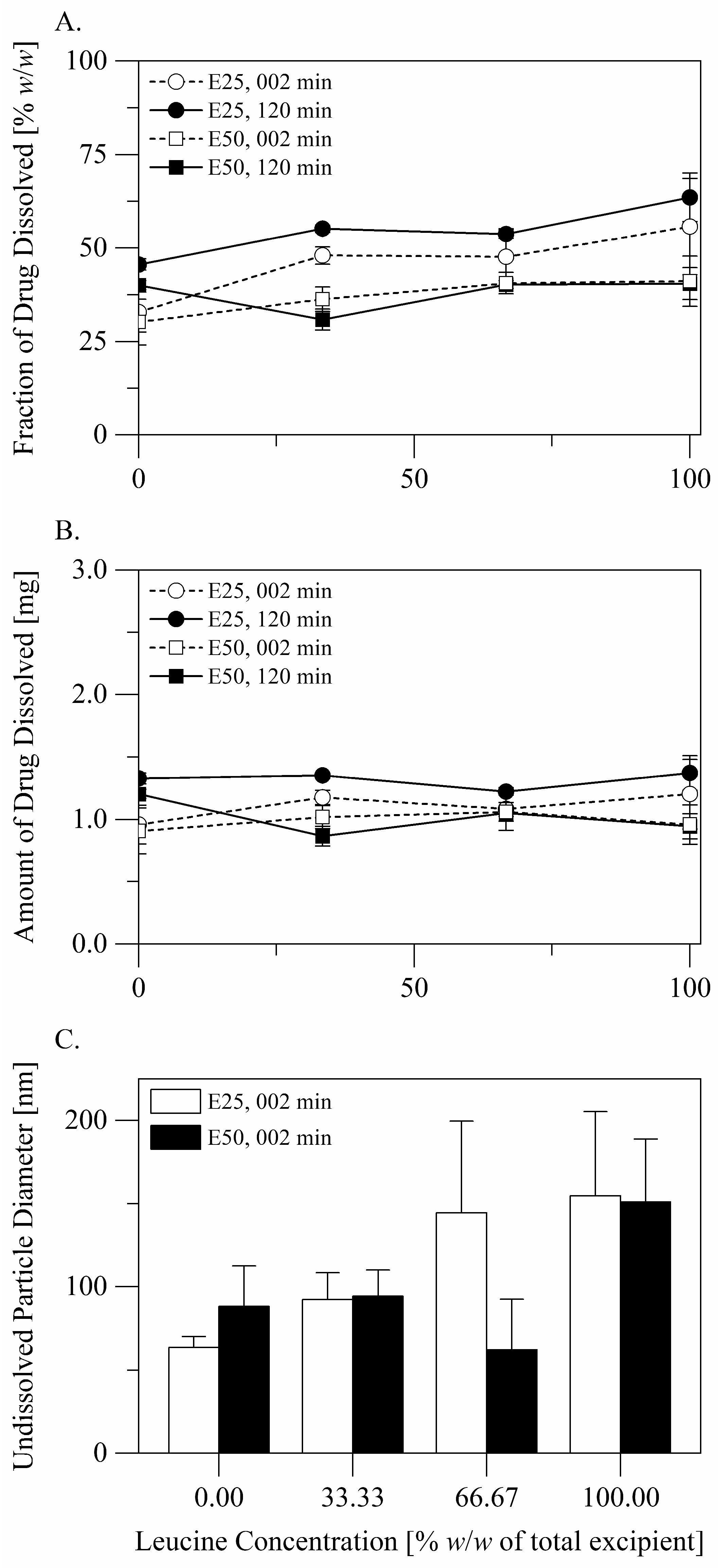
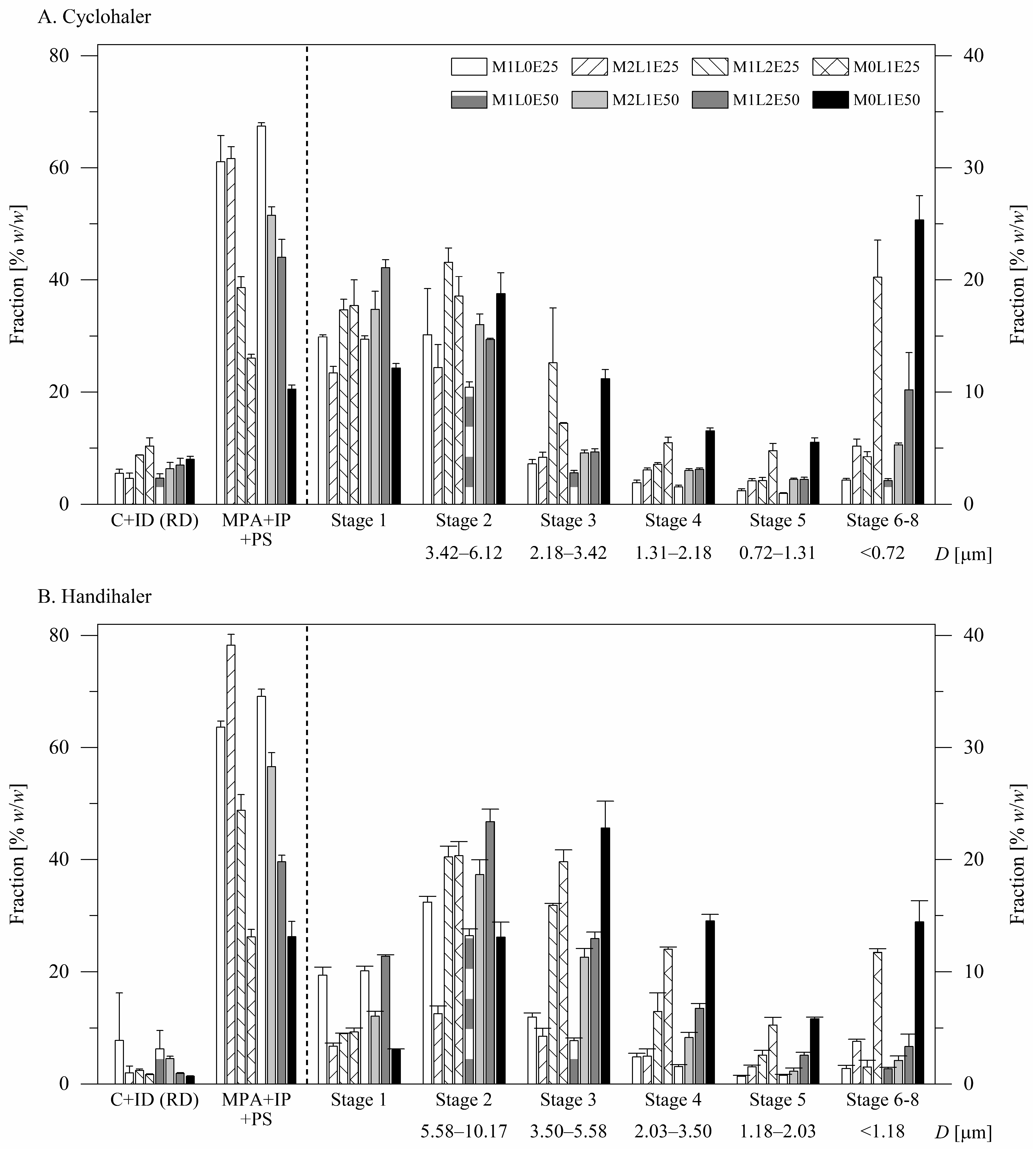
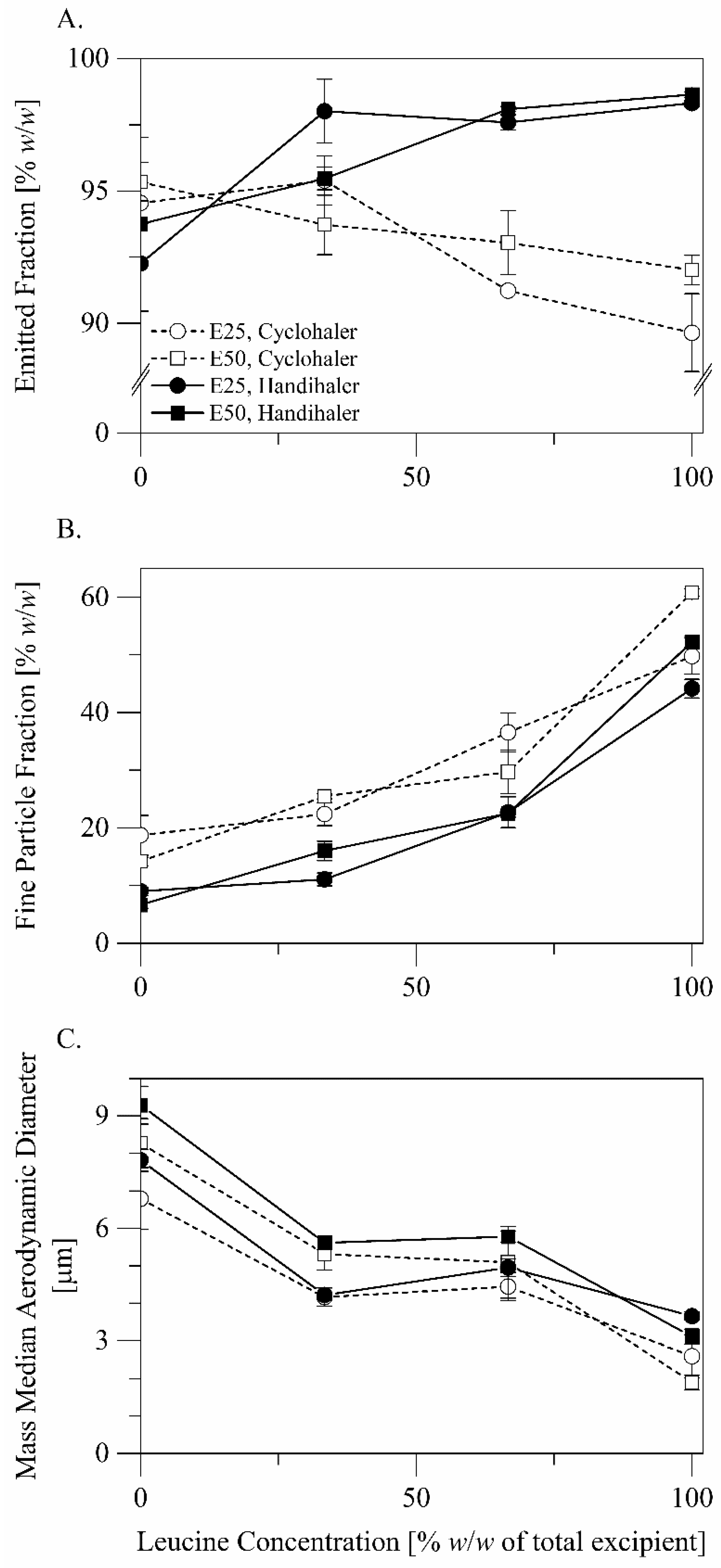
| Formulation a | Spray Solution Composition b [% w/w in Deionized Water] | Nominal Particle Composition [% w/w] | |||||
|---|---|---|---|---|---|---|---|
| Drug | Mannitol | Leucine | Ethanol | Drug | Mannitol | Leucine | |
| M1L0E25 | 0.113 | 0.638 | 0.000 | 24.813 | 15.00 | 85.00 | 0.00 |
| M2L1E25 | 0.113 | 0.425 | 0.212 | 24.813 | 15.00 | 56.70 | 28.31 |
| M1L2E25 | 0.113 | 0.212 | 0.425 | 24.813 | 15.00 | 28.31 | 56.70 |
| M0L1E25 | 0.113 | 0.000 | 0.638 | 24.813 | 15.00 | 0.00 | 85.00 |
| M1L0E50 | 0.113 | 0.638 | 0.000 | 49.625 | 15.00 | 85.00 | 0.00 |
| M2L1E50 | 0.113 | 0.425 | 0.212 | 49.625 | 15.00 | 56.70 | 28.31 |
| M1L2E50 | 0.113 | 0.212 | 0.425 | 49.625 | 15.00 | 28.31 | 56.70 |
| M0L1E50 | 0.113 | 0.000 | 0.638 | 49.625 | 15.00 | 0.00 | 85.00 |
| Formulation | Yield a [% w/w] | Loading Efficiency b [% w/w] | Drug Recovery [% w/w] |
|---|---|---|---|
| M1L0E25 | 44.6 ± 1.4 | 97.2 ± 3.0 | 43.3 ± 1.9 |
| M2L1E25 | 51.4 ± 13.2 | 81.7 ± 5.3 | 42.0 ± 11.1 |
| M1L2E25 | 67.7 ± 10.7 | 75.9 ± 2.3 | 51.4 ± 8. 3 |
| M0L1E25 | 59.8 ± 7.2 | 71.9 ± 3.8 | 43.0 ± 5.6 |
| M1L0E50 | 47.7 ± 11.1 | 100.2 ± 4.7 | 47.8 ± 11.4 |
| M2L1E50 | 56.0 ± 10.0 | 93.5 ± 1.3 | 52.3 ± 9.4 |
| M1L2E50 | 60.4 ± 0.3 | 87.0 ± 1.2 | 52.6 ± 0.8 |
| M0L1E50 | 60.8 ± 5.7 | 77.8 ± 2.2 | 47.3 ± 4.6 |
| Factor | Emitted Fraction | Fine Particle Fraction | MMAD b |
|---|---|---|---|
| Excipient (leucine concentration) | NS | S *** | S *** |
| Spray solvent (ethanol concentration) | NS | S ** | S *** |
| Inhaler (Handihaler vs. Cyclohaler) | S *** | S *** | S *** |
| Excipient × Solvent | NS | S *** | S *** |
| Excipient × Inhaler | S *** | NS | NS |
| Spray solvent × Inhaler | NS | NS | NS |
Publisher’s Note: MDPI stays neutral with regard to jurisdictional claims in published maps and institutional affiliations. |
© 2021 by the authors. Licensee MDPI, Basel, Switzerland. This article is an open access article distributed under the terms and conditions of the Creative Commons Attribution (CC BY) license (https://creativecommons.org/licenses/by/4.0/).
Share and Cite
Almansour, K.; Alfagih, I.M.; Aodah, A.H.; Alheibshy, F.; Ali, R.; Al Hagbani, T.; Elsayed, M.M.A. Inhalable, Spray-Dried Terbinafine Microparticles for Management of Pulmonary Fungal Infections: Optimization of the Excipient Composition and Selection of an Inhalation Device. Pharmaceutics 2022, 14, 87. https://doi.org/10.3390/pharmaceutics14010087
Almansour K, Alfagih IM, Aodah AH, Alheibshy F, Ali R, Al Hagbani T, Elsayed MMA. Inhalable, Spray-Dried Terbinafine Microparticles for Management of Pulmonary Fungal Infections: Optimization of the Excipient Composition and Selection of an Inhalation Device. Pharmaceutics. 2022; 14(1):87. https://doi.org/10.3390/pharmaceutics14010087
Chicago/Turabian StyleAlmansour, Khaled, Iman M. Alfagih, Alhassan H. Aodah, Fawaz Alheibshy, Raisuddin Ali, Turki Al Hagbani, and Mustafa M.A. Elsayed. 2022. "Inhalable, Spray-Dried Terbinafine Microparticles for Management of Pulmonary Fungal Infections: Optimization of the Excipient Composition and Selection of an Inhalation Device" Pharmaceutics 14, no. 1: 87. https://doi.org/10.3390/pharmaceutics14010087
APA StyleAlmansour, K., Alfagih, I. M., Aodah, A. H., Alheibshy, F., Ali, R., Al Hagbani, T., & Elsayed, M. M. A. (2022). Inhalable, Spray-Dried Terbinafine Microparticles for Management of Pulmonary Fungal Infections: Optimization of the Excipient Composition and Selection of an Inhalation Device. Pharmaceutics, 14(1), 87. https://doi.org/10.3390/pharmaceutics14010087





